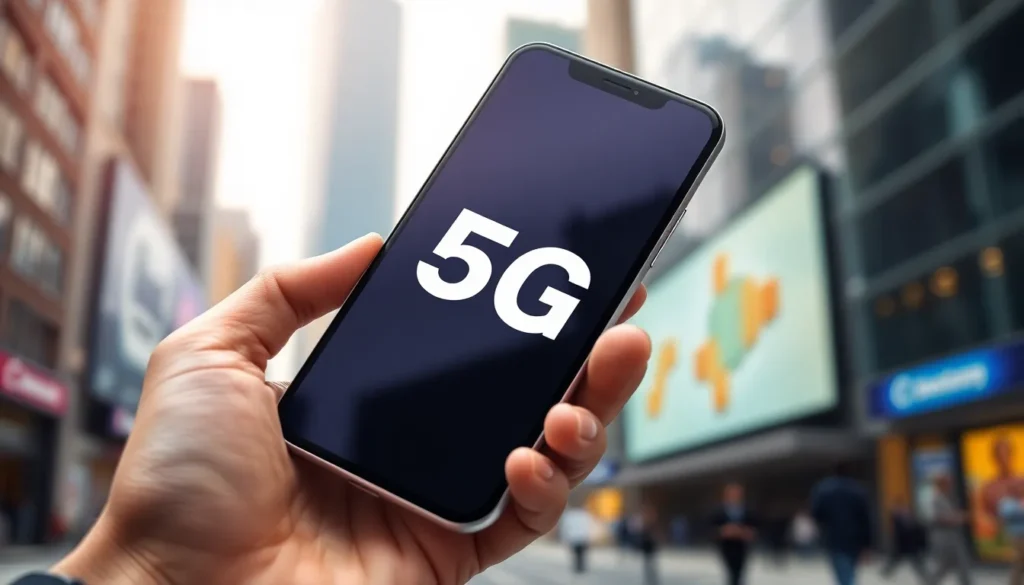Ever spotted “UC” next to that shiny 5G icon on your phone and wondered if it’s some secret code for an elite club? You’re not alone! As 5G networks roll out, acronyms can feel like a game of Scrabble gone wrong. But don’t worry, decoding “UC” is easier than finding a decent Wi-Fi signal in a coffee shop.
Table of Contents
ToggleUnderstanding UC in 5G Networks
UC stands for “Ultra Capacity.” This term highlights an advanced feature of 5G networks aimed at enhancing data speeds and network efficiency. Ultra Capacity facilitates improved performance for users, enabling faster downloads and smoother streaming experiences.
Some carriers incorporate UC alongside 5G to indicate the use of mid-band and millimeter wave frequencies. These frequencies provide higher capacity and greater coverage compared to previous technologies. With UC, users experience robust connectivity, particularly in densely populated areas where traditional coverage may falter.
Many smartphone users notice the UC label when accessing the network. The presence of UC suggests that the device is connected to a 5G network optimized for speed, which translates to better performance during high-demand activities such as gaming or video conferencing. Users benefit from quicker response times and reduced latency, enhancing everyday tasks.
Carriers often leverage UC to market their superior network capabilities. These advertising strategies emphasize that Ultra Capacity enables a more reliable connection, performing well even during peak usage times. Furthermore, UC plays a crucial role in supporting emerging technologies and applications, ultimately driving the future of mobile connectivity.
Knowledgeable users seek devices that offer UC compatibility to maximize their 5G experience. Understanding Ultra Capacity is essential for making informed choices regarding devices and service plans. With this knowledge, users can enjoy the full capabilities of their smartphones while connected to advanced 5G networks.
The Significance of UC

Understanding UC, or Ultra Capacity, offers insight into network performance and user experience. This feature significantly enhances the 5G landscape.
Advantages of UC Technology
UC technology delivers multiple advantages that enhance user experiences. Faster data speeds allow users to download large files in moments. Improved network efficiency decreases congestion, providing seamless connectivity even during peak hours. Greater coverage in busy urban areas ensures users remain connected, reducing dropout rates. Enhanced reliability benefits activities such as streaming and gaming, fostering uninterrupted enjoyment. Overall, UC technology elevates the 5G experience for everyone.
Use Cases for UC
Many practical applications illustrate the value of UC in everyday life. High-definition video streaming becomes effortless, eliminating buffering delays. Remote work benefits from faster upload speeds, improving collaboration through video conferences. Smart cities utilize UC to support real-time data exchange, enhancing traffic management and public safety. Educational platforms leverage faster connections for online learning, ensuring students receive quality content. Various industries witness improved performance, highlighting the transformative potential of UC in modern communications.
Differences Between UC and Other 5G Indicators
UC stands for “Ultra Capacity” and differs significantly from other 5G indicators like 5G NR or 5G E. While 5G NR, which means New Radio, refers to the overall 5G technology standard, UC specifically highlights enhanced data capacity. It focuses on mid-band and millimeter wave frequencies, allowing for higher speeds and broader coverage in congested areas.
5G E, often seen on smartphones, refers to “5G Evolution.” This label indicates an upgraded 4G LTE network rather than true 5G technology. Users looking for optimal performance should recognize that UC provides a clearer indication of advanced capabilities.
When comparing UC to standard 5G, the benefits become evident. Standard 5G indicates the basic presence of 5G technology, while UC showcases network enhancements that drive user experience. Users enjoying UC usually experience faster download speeds and smoother streaming, particularly during peak usage times.
Moreover, UC is associated directly with carriers’ marketing strategies. Carriers highlight UC to emphasize superior service, especially in dense urban settings. This approach clearly distinguishes UC as a premium feature, enhancing reliability and performance.
Key metrics differentiate UC from other indicators. Users connected to UC networks are likely to enjoy better performance in activities such as gaming, video conferencing, and high-definition streaming. Data indicates that Ultra Capacity significantly improves overall network efficiency and user satisfaction.
Understanding the distinctions between UC and other 5G indicators is important for consumers. Awareness of UC’s advanced capabilities helps users make informed decisions about devices and service plans, ultimately leading to an enhanced 5G experience.
How UC Affects User Experience
UC significantly enhances user experience by improving data speeds and network efficiency. Users benefit from faster downloads, with many reporting speeds that reach up to 1 Gbps in ideal conditions. Enhanced network capacity plays a crucial role in busy urban areas where data demand spikes.
Streaming high-definition video becomes seamless on a UC-enabled network. Viewers enjoy smoother playback, even during peak viewing times, thanks to minimal buffering. Gaming enthusiasts experience lower latency and faster response times, which are vital for competitive play.
Remote work capabilities receive a boost as well. Improved connections facilitate effective video conferencing and real-time collaboration, making it easier for teams to work together from different locations.
Moreover, UC technology contributes to smart city innovations. Cities leverage this capacity for better management of traffic, public services, and communication networks. Online learning also thrives on UC networks, allowing students to participate in live classes without interruptions.
Understanding the difference between UC and other 5G indicators like 5G NR or 5G E is essential for consumers. While 5G NR represents the overall 5G standard, UC clearly signals advanced data capabilities. Users gain significant benefits from UC, especially during times of high network demand.
Awareness of UC enhances users’ decision-making when selecting devices or service plans. A clear grasp of UC’s advantages leads to a richer 5G experience, underscoring the importance of this technology in today’s connectivity landscape.
Understanding what UC means next to 5G is crucial for anyone looking to maximize their mobile experience. As “Ultra Capacity” networks become more prevalent, users can enjoy faster speeds and improved performance, especially in crowded areas. This technology not only enhances everyday activities like streaming and gaming but also supports emerging innovations in smart cities and remote work.
By recognizing the significance of UC, consumers can make informed choices about their devices and service plans. As 5G continues to evolve, being aware of these advancements ensures a richer and more reliable connectivity experience. Embracing UC technology is a step toward fully harnessing the potential of 5G networks.




